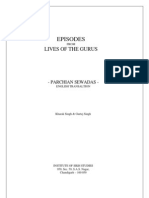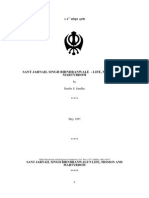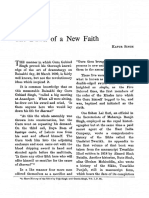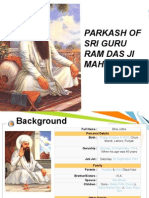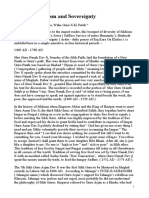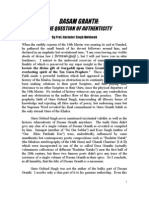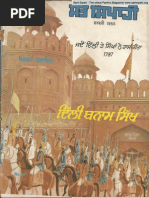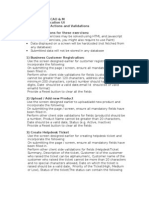Operation Blue Star PDF
Operation Blue Star PDF
Uploaded by
gurpreet2501Copyright:
Available Formats
Operation Blue Star PDF
Operation Blue Star PDF
Uploaded by
gurpreet2501Original Title
Copyright
Available Formats
Share this document
Did you find this document useful?
Is this content inappropriate?
Copyright:
Available Formats
Operation Blue Star PDF
Operation Blue Star PDF
Uploaded by
gurpreet2501Copyright:
Available Formats
Operation Blue Star
Operation Blue Star
Operation Blue Star (Punjabi: , Hindi: (bly sr)) 36 June 1984 was an Indian military
operation, ordered by Indira Gandhi, then Prime Minister of India,[1] to remove Sikh separatists from the Golden
Temple in Amritsar. The separatists, led by Jarnail Singh Bhindranwale, were accused of amassing weapons in the
Sikh temple and starting a major armed uprising.[2] These reasons are contested by some Sikhs who claim that Akal
Takhat is a temporal seat and keeping weapons in Gurdwaras is well within the precincts of Sikhism. Dr Harjinder
Singh Dilgeer says that Indira Gandhi attacked Darbar Sahib to present herself as a great hero in order to win
forthcoming elections.[3]
The operation had two components --Operation Metalconfined to Golden Temple complex andOperation
Shopto raid the countryside all over the Punjab to capture any suspects.[4] Following it, a complementary
operation was launched code-named: Operation Woodrose for thoroughly scanning the Punjab countryside to round
up any suspects.
The operation was carried out by Indian army troops with tanks, artillery, helicopters and armoured vehicles.[5]
Actual casualty figures given by Kuldip Singh Brar put the number of deaths among the Indian army at 83 and
injuries at 220.[6] According to the official estimate, 492 civilians were killed.[7][8] The military action led to an
uproar amongst Sikhs worldwide and the increased tension following the action led to assaults on members of the
Sikh community within India. Many Sikh soldiers in the Indian army mutinied, many Sikhs resigned from armed and
civil administrative office and a few returned awards and honours they had received from the Indian government.[9]
Four months after the operation, on 31 October 1984, Indira Gandhi was assassinated by two of her Sikh bodyguards
in what is viewed as an act of vengeance. Following her assassination, more than 5000 Sikhs were killed in anti-Sikh
pogroms.[10] Within the Sikh community itself, Operation Blue Star has taken on considerable historical significance
and is often compared to what Sikhs call 'the great massacre' by the Afghan invader Ahmad Shah Durrani, the Sikh
holocaust of 1762.[11]
Sikh billboard, Michigan, USA
Operation Blue Star
The Operation
Indira Gandhi first asked Lt. Gen. S. K. Sinha, then Vice-Chief of
Indian Army and who was to succeed as the Army chief, to prepare a
position paper for assault on the Golden Temple.[13] Lt. Gen. Sinha
advised against any such move, given its sacrilegious nature according
to Sikh tradition. He suggested the government adopt an alternative
solution. A controversial decision was made to replace him with
General Arun Shridhar Vaidya as the Chief of the Indian army.
General Vaidya, assisted by Lt. Gen. K Sundarji as Vice-Chief,
planned and coordinated Operation Blue Star.[13]
The Indian Army used seven Vijayanta Tanks
[12]
On 3 June, a 36-hour curfew was imposed on the state of Punjab with
during the operation
[14]
all methods of communication and public travel suspended.
Electricity supplies were also interrupted, creating a total blackout and cutting off the state from the rest of India and
the world.[15] Complete censorship was enforced on the news media.[15]
The Indian Army stormed the Golden Temple on the night of 5 June under the command of Kuldip Singh Brar. The
forces had full control of the Golden Temple by the morning of 7 June. There were casualties among the army,
civilians, and militants. Sikh leaders Bhindranwale and Shabeg Singh were killed in the operation.[16]
Jarnail Singh Bhindranwale in the Golden Temple
Throughout his career Jarnail Singh Bhindranwale remained in contact with Indira Gandhi.[17][18] Bhindranwale had
earlier taken residence in the Golden temple and made it his headquarters in April 1980, when he was behind the
assassination of Nirankari Gurbachan Singh.[19] The Nirankari Baba, also known as Baba Gurbachan, had been the
target of an attack by followers of Jarnail, outside the Golden Temple. On 13 April 1978, Nirankari's Baba
Gurbachan is alleged to have ridiculed 10th Guru Gobind Singh in a Nirankari Convention held in Amritsar. This
prompted Akhand Kirtani Jatha to lead a protest against the offensive actions by Baba Gurbachan. Police responded
to the sikhs protest by opening fire on them. Amritsar police used guns to fire at the protesters. In the ensuing
violence, several people were killed: two of Bhindranwale's followers, eleven members of the Akhand Kirtani Jatha
(total 13 sikhs) and three Nirankaris.[20]
In 1982, Bhindranwale and approximately 200 armed followers moved into a guest-house called the Guru Nanak
Niwas, in the precinct of the Golden Temple.[21] From here he met and was interviewed by international television
crews.[21]
On 23 April 1983, the Punjab Police Deputy Inspector General A. S. Atwal was shot dead as he left the Golden
Temple compound. The following day, after the murder, Harchand Singh Longowal (then president of Shiromani
Akali Dal) hinted at the involvement of Bhindranwale in the murder.[22]
On 15 December 1983, Bhindranwale was forced to move out of Guru Nanak Niwas house by members of the
Babbar Khalsa who acted with Harcharan Singh Longowal's support Longowal by now feared for his own safety. By
1983, the Golden Temple became a fort for a large number of militants.[23]
The Golden Temple compound and some of the surrounding houses were fortified. The Statesman reported on 4 July
that light machine-guns and semi-automatic rifles were known to have been brought into the compound.[24] Faced
with imminent army action and with the foremost Sikh political organisation, Shiromani Akali Dal (headed by
Harchand Singh Longowal), abandoning him, Bhindranwale declared "This bird is alone. There are many hunters
after it".[25]
Time magazine reported (about Amritsar) that:[26]
Operation Blue Star
These days it more closely resembles a city of death. Inside the temple compound, violent Sikh fanatics wield
submachine guns, resisting arrest by government security forces. Outside, the security men keep a nervous
vigil, all too aware that the bodies of murdered comrades often turn up in the warren of tiny streets around the
shrine.
Overview
Operation Blue Star was launched to eliminate Jarnail Singh Bhindranwale and his followers who had sought cover
in the Amritsar Golden Temple Complex. The armed Sikhs within the Harminder Sahib were led by Jarnail Singh
Bhindranwale and former Maj. Gen.Shabeg Singh. lt. Gen. Kuldip Singh Brar had command of the action, operating
under Gen. Sunderji.
1 June 1984
At 12h40 the CRPF starts firing at "Guru Ram Das Langar" building. The Border Security Force and the Central
Reserve Police Force, under orders of the Army started firing upon the Complex, in which at least 8 people died.
2 June 1984
The Indian army had already sealed the international border from Kashmir to Ganga Nagar, Rajasthan. At least seven
divisions of army are deployed in villages of Punjab. By the nightfall media and the press were gagged; the rail, road
and air services in Punjab were suspended. Foreigners' and NRIs' entry was also banned . General Gauri Shankar was
appointed as the Security Advisor to the Governor of Punjab. The water and electricity supply was cut off.
3 June 1984
A complete curfew is observed with the army and para-military patrolling the whole Punjab. The army seals of all
routes of ingress and exit around the temple complex. There is an incessant exchange of fire during the night
between 3 and 4 June. Neither side is victor or vanquished but the army was beaten back.
4 June 1984
The army started bombarding the historic Ramgarhia Bungas, the water tank, and other fortified positions. The army
used Ordnance QF 25 pounder and achieved the objective of destroying outer defences laid by General Shabeg
Singh. The army then placed tanks and APCs on the road separating the Guru Nanak niwas building, thus forming a
wall of iron. About 100 died In pitched battles from both sides.[27]
Nearly fifty thousand Sikhs gathered in the Golewal village about 25km from Amritsar to fight the army, thirty
thousand converged from the side of Batala in Gurdaspur district and about twenty thousand Sikhs gathered at Chauk
Mehta, the headquarters of Damdami Taksal. Another formation of about twenty thousand were marching from the
side of Harik Patan at confluence of the rivers Sutlej and Beas.
The army helicopters spotted the massive movements. General K. Sunderji sent tanks and APCs.
Hundreds/thousands of Sikhs were killed at the rendezvous.[28]
The artillery and small arms firing stopped for a while, and Gurcharan Singh Tohra, former head of SGPC was sent
to negotiate with Bindrawale; however, he was unsuccessful and returns. The firing resumes.
Operation Blue Star
5 June 1984
In the morning, shelling started on the building inside the Golden Temple complex.[29]
The 9th division launched a frontal attack; however, it was unable to secure the Akal Takhat.
1900 hrs
The Army simultaneously attacked various other Gurdwaras. The White paper mentions 42, but some accounts
mention 74.[27]
22000400 hrs
Late in the evening, the generals decided to launch a simultaneous attack from three sides. Commandos from the 1st
Battalion Parachute Regiment would attack from the main entrance of the complex, the 10th Battalion of the Guards
from the northern entrance, and Madras and Garhwal battalions from the hostel complex side entrance.
As the commandos entered the temple they were gunned down by light machine-gun fire from both sides of the
steps/stair-case. The few commandos who did get down the steps were driven back by a barrage of fire from the
building on the south side of the sacred pool, forcing them to fall back, and thus they ultimately failed to reach the
pavement around the Sacred Pool.
A second collective attempt by the Guards and the Commandos managed to reach the pavement around the Pool;
however they came under heavy fire from all sides. Crawling was impossible as Shabeg Singh had placed light
machine guns nine or ten inches above the ground. This attempt caused many casualties among the Indian troops.
A third attempt to gain the Pool was made by a squad of 200 troops from both the Commandos and the Guards. On
the southern side, the Madras and Garhwal battalions were not able to make it to the pavement around the pool
because they were engaged by positions on the southern side.
India Today reported that Madrasis, being 5 hours late, straight away started firing at Brig. Diwan's Garhwalis. Fifty
soldiers were killed before things could be sorted out.[30][31]
Despite the mounting casualties, General Sunderji ordered a fourth assault by the Commandos. This time the Madras
battalion was reinforced with two more companies of the 7th Garhwal Rifles under the command of General K S
Brar. However, the Madras and Garhwal troops under Brigadier A K Diwan once again failed to report any
successful movement towards the parikarma (pavement around the pool).
Brigadier Diwan reported heavy casualties and requested more reinforcements. General Brar sent two companies of
15 Kumaon Regiment. This resulted in yet more heavy casualties, forcing Brigadier Diwan to request tank support.
Brar also requested tank support after an APC was destroyed by a rocket fired by a Sikh militant. His request was
granted and seven tanks rolled into the Golden Temple complex.
By 05h00 June 6, due to the 105mm shelling by Vijayanta the Akal Takhat was destroyed. However, the primary
objective of removing militants from other neighbouring structures continued for a further 24 hours.
Operation Blue Star
1100 hrs
A group trying to escape from Akal Takht was mowed down by machine gun fire.
The resistance continues from the neighbouring structures of the Akal Takhat.
7 June 1984
Army gains complete control of the Golden Temple complex. The Toshakhana, treasure house, of the Golden
Temple was systematically looted.[32]
810 June 1984
The Army fights about four militant Sikhs holed up in basement of a tower. A Colonel of Commandos is shot dead
by LMG burst while trying to force his way into the basement. By afternoon 10 June, the entire operation is
completed by the army.
Greatest Battle of Resistance
To quote Dr Harjinder Singh Dilgeer, this was the greatest battle of resistance in the history of the world: "About
fifty thousand soldiers of the Indian Army, known as the third greatest army of the world, with all its three wings
(Army, Air Force and Navy), fully equipped with helicopters, tanks, cannons, guns and unlimited ammunition as
well as all sorts of provisions, and with endless supply of everything and other facilities, attacked Darbar Sahib
Complex to capture just 444 square feet area; and, on the other hand, just a few ordinary Sikhs, around 125, who did
not have even proper training to fire guns, and had nothing to eat or drink and no back up or supply for all the period
of battle, without having a wink of sleep for more than seventy-two hours, resisted such a mammoth army for more
than three days; hence this was perhaps the greatest battle of resistance in the history of the world." [33]
Casualties
The Army placed total casualties at:[6]
Military: 83 (4 officers, 16 Junior Commissioned Officers and 75 other ranks) and 220 wounded.
Civilians: 492 dead
Militants: 433 out of the 1592 people apprehended were segregated as militants
Some of the estimates include:[34]
Authors/Officials
Casualties
Indian Government white paper category civilian/terrorist 493
Combatants killed
AP, Reuters and New York Times (11 June 1984)
1,000
Author Mark Tully's (Amritsar, Mrs. Gandhi's last battle)
2,093
Amritsar crematorium worker
3,300
Author Chand Joshi (Bhindranwale: Myth and Reality)
5,000
Eyewitnesses
8,000
Author A R Darshi (The Gallant Defender)
5,000 (most conservative)
Operation Blue Star
Source
Casualties
Government White Paper 200, 35 bodies in Akal Takht
200
A.I.S.S.F. Member 100 fighters 5 June
100
S.S. Bhagowalia, V.P. Association for Democratic Rights 140150
Indian Government White Paper
Government source
casualties
Own troops killed
83
Own troops wounded
249
Innocent killed
493
injured
86
Civilians/Sikh's apprehended 1,592
According to some journalists, several Sikh youths were also killed in crossfire from militants.[35]
Unofficial casualty figures were much higher.[36]
Mark Tully and Satish Jacob mention of use of tanks by the army at Sultanwind area over the civilian Sikhs
marching towards Amritsar.[37]
According to the independent sources number of military personnel dead amount to more than at least 700.[38] In one
of his speeches Rajiv Gandhi, the former prime minister of India, admitted to have lost more than 700 soldiers in this
operation. CNN-IBN on the 25 death anniversary of Indira Gandhi, i.e. 31 Oct 2009, reported to have lost 365
commandos.[39] Apart from this, an unspecified number of soldiers have been reported dead during the fighting at 38
other Gurdwaras in Punjab where an extreme resistance was reported at Muktsar and Moga.[40] On top of this, more
number of Indian army personnel would have perished during mutinies by Sikh soldiers at different military
locations across India.[40]
In one of the most cited instances, the sikh soldiers-recruits at Sikh regimental center Ramgarh killed their
Commanding Officer and after looting the arsenal started a long journey towards Punjab. And they could be
restrained only after a massive resistance.[40]
Honouring Invading Soldiers
To quote Dr Dilgeer, "During the attack on Darbar Sahib, the Indian Army had behaved as brutal enemies; no
warnings, no attempts to save innocent pilgrims, indiscriminate killings, inhuman treatment with the dead, no
handing over the dead to their relatives, keeping no records of the dead, burning of bodies without identification,
cremating the dead bodies by pouring kerosene oil and petrol on them, perpetrating atrocities on the arrested Sikhs
by keeping them in small cells without water and thus killing several of them, killing those prisoners who begged for
water (this being the hottest month of the year), detaining babies and children (for months) were among the great
achievements of the Indian Army. What the Indian Army did had no parallels in the world history; most ferocious
invaders had not behaved in such savage manner; still the Indian Government presented these inhuman soldiers and
generals with gallantry Awards, honours, decoration strips, promotions etc. for their heroic acts; this special Award
Ceremony was performed on the 10th of July 1985. It is amazing to note that the Indian Government had not
honoured the brave soldiers who had performed acts of chivalry during the battles of 1962, 1965 and 1971;
honouring of those who had perpetrated atrocities on its own people and had crossed all the limits of inhuman acts
was shocking and shameful; however it exposed the Sikh-hatred of the Indian regime; further shocking is that these
Awards were given by Sikh looking President; so devoid of self respect he was!" [41]
Operation Blue Star
Aftermath
At least 4000[42] Sikh soldiers mutinied at different locations in India in protest, with some reports of large-scale
pitched battles being fought to bring mutineers under control.[43]
The operation also led to the assassination of Prime Minister Indira Gandhi on 31 October 1984 by two of her Sikh
bodyguards,[44] triggering the 1984 anti-Sikh riots. The widespread killing of Sikhs, principally in the national
capital Delhi but also in other major cities in North India, led to major divisions between the Sikh community and
the Indian Government. The army withdrew from the Golden Temple later in 1984 under pressure from Sikh
demands.[45]
General A S Vaidya, the Chief of Army Staff at the time of Operation Blue Star, was assassinated in 1986 in Pune by
two Sikhs, Harjinder Singh Jinda and Sukhdev Singh Sukha. Both were sentenced to death, and hanged on 7 October
1992.
Sikh militants continued to use and occupy the temple compound and on 1 May 1986, Indian paramilitary police
entered the temple and arrested 200 militants that had occupied the Golden Temple for more than three months.[46]
On 2 May 1986 the paramilitary police undertook a 12-hour operation to take control of the Golden Temple at
Amritsar from several hundred militants, but almost all the major radical leaders managed to escape.[47] In June
1990, the Indian government ordered the area surrounding the temple to be vacated by local residents in order to
prevent militant activity around the temple.[48] Dr. Sangat Singh, member of Joint Intelligence Committee India, in
his book, The Sikhs in history, mentions that almost half of these were fake Sikhs actually the RAW agents.[49]
Criticisms
The use of artillery in the congested inner city of Amritsar proved deadly to many civilian bystanders living near the
Golden Temple. The media blackout throughout the Punjab resulted in widespread doubt regarding the official
stories and aided the promotion of hearsay and rumour.[50] The operation is criticised on four main grounds, the
choice of time of attack by Government, heavy casualty, loss of property, and allegation of human rights violations
by Army personnel.
Special Magistrate of Punjab Mr.A R Darshi writes in his book, The Gallant Defender: "Brutalities committed by the
Indian Army on the Sikhs during Operation Blue Star, were shocking and terrific. Innocent Sikhs old, young and
children, were mercilessly slaughtered. Women were raped by the soldiers."
G.K.C Reddy writes "Thus the Operation Bluestar will go down in the history as one of the biggest massacres of
unarmed civilians by the organised military force of a nation." [51]
Chand Joshi writes "Army units acted in total anger and unwittingly shot down all the suspects rounded up from
Golden Temple complex". [52]
BBC's Mark Tully (and Satish Jacob), Amritsar; Mrs. Gandhi's Last Battle, wrote "Any army which wants to destroy
a nation destroys its culture. That is why Indian army burnt the Sikh [Reference] Library."
Operation Blue Star
"Last resort"
The attack on Golden Temple was in plans before the armed Sikh militants fortified it.[53] Then GOC of the Indian
Army, S. K. Sinha, who was sacked at the last moment had criticised the Government's claim that the attack
represented a "last resort". Some Sikhs have alleged that the army had been rehearsing the operation in a replica of
the Golden Temple at a secret location near Chakrata Cantonment in the Doon Valley.[54]
Timing
The timing of Operation Blue Star coincided with a Sikh religious day, the martyrdom of Guru Arjan Dev, the
founder of the Golden Temple. Sikhs from all over the world visit the temple on this day. In 1736 the Golden
Temple was attacked by the Mughal army, resulting in heavy casualties of civilian Sikhs.[55] The attack of Ahmad
Shah Abdali on the Golden Temple (Darbar Sahib) also came on Baisakhi day, when Sikhs gather in large numbers
in Amritsar. Many Sikhs view the timing and attack by the Indian Army as an attempt to inflict maximum casualties
on Sikhs and demoralise them,[56] and the government is in turn blamed for the inflated number of civilian dead for
choosing to attack on this day.
The Sikh community's anger and suffering was further increased by comments from leading newspaper editors, such
as Ramnath Goenka, terming the operation as "A greater victory than the win over Bangladesh, this is the greatest
victory of Mrs. Gandhi".[57]
Media Blackout
Before the attack by army a media blackout was imposed in Punjab.[58] The
Times reporter Michael Hamlyn reported that journalists were picked up from
their hotels at 5am in a military bus, taken to the adjoining border of the state
of Haryana and "were abandoned there".[58] The main towns in Punjab were
put under curfew, transportation was banned, news blackout was imposed and
Punjab was "cut off from the outside world".[59] A group of journalists who
later tried to drive into Punjab were stopped at the road block at Punjab
border and were threatened to be shot if they proceeded.[58] The Indian
nationals who worked with the foreign media were also banned.[58] The press
criticized these actions by Government as an "obvious attempt to attack the
temple without the eyes of foreign press on them".[60] Associated Press
reporter Brahma Chellaney, who managed to report on the operation, later
faced police intimidation.[61][62]
Human rights
Brahma Chellaney was the only reporter
for a foreign news service in Amritsar
during the media blackout.
Brahma Chellaney, who was then the South Asia correspondent of the
Associated Press, was the only foreign reporter who managed to stay on in Amritsar despite the media blackout.[] His
dispatches, filed by telex, provided the first non-governmental news reports on the bloody operation in Amritsar. His
first dispatch, front-paged by the New York Times, The Times of London and The Guardian, reported a death toll
about twice of what authorities had admitted. According to the dispatch, about 780 militants and civilians and 400
troops had perished in fierce gunbattles. The high casualty rates among security forces were attributed to "the
presence of such sophisticated weapons as medium machine guns and rockets" in the militants arsenal.[63] Mr.
Chellaney also reported that several suspected Sikh militants had been shot with their hands tied.[64] The dispatch,
after its first paragraph reference to several such deaths, specified later that eight to 10 men had been shot in that
fashion.[65] In that dispatch, Mr. Chellaney interviewed a doctor who said he was picked up by the army and forced
to conduct postmortems despite the fact he had never done any postmortem examination before.[64] The number of
Operation Blue Star
casualties reported by Mr. Chellaney were far more than government reports,[66] and the Indian government, which
disputed his casualty figures[67] accused him of inflammatory reporting.[68] The Associated Press stood by the
reports and figures, the accuracy of which was also "supported by Indian and other press accounts" according to
Associated Press; and reports in The Times and The New York Times.[69]
C. K. C. Reddy, an Indian journalist Please provide organisation and credibility of this journalist writes that the
Whole of Punjab and especially the Golden Temple Complex was turned into a murderous mouse trap from
where people could neither escape nor could they seek succor of any kind. The way the dead bodies were
disposed off adds to the suspicions regarding the number and nature of the casualties. The bodies of the
victims of military operation in Punjab were unceremoniously destroyed without any attempt to identify them
and hand them over to their relatives. The government, after the operation, on the other hand, did every thing
in its power to cover up the excesses of the army action. The most disturbing thing about the entire operation
was that a whole mass of men, women, and children were ordered to be killed merely on the suspicion that
some terrorists were operating from the Golden Temple and other Gurdwaras.[70]
Similar accusations of high handedness by the Indian Army and allegations of human rights violations by security
forces in Operation Blue Star and subsequent military operations in Punjab have been levelled by Justice V. M.
Tarkunde,[71] Mary Anne Weaver,[72] human rights lawyer Ram Narayan Kumar,[73] and anthropologists Cynthia
Mahmood and Joyce Pettigrew.[74][75][76]
The Indian Army responded to this criticism by stating that they "answered the call of duty as disciplined, loyal and
dedicated members of the Armed Forces of India...our loyalties are to the nation, the armed forces to which we
belong, the uniforms we wear and to the troops we command"[77]
It was later pointed out that as the blockade approach taken by Rajiv Gandhi five years later in Operation Black
Thunder, when Sikh militants had again taken over the temple complex, was highly successful as they managed to
resolve the stand-off peacefully and in hindsight, Operation Blue Star could have been averted by using similar
blockade tactics. The army responded by stating that "no comparison is possible between the two situations", as
"there was no cult figure like Bhindranwale to idolise, and professional military general like Shahbeg Singh to
provide for military leadership" and "confidence of militants having been shattered by Operation Blue Star".[77]
Furthermore, it is pointed out that the militants in the temple were armed with machine guns, anti tank missiles and
rocket launchers, and that they strongly resisted the army's attempts to dislodge them from the shrine, appearing to
have planned for a long stand-off, having arranged for water to be supplied from wells within the temple compound
and had stocked food provisions that could have lasted months.[77]
References
[1] "Operation BlueStar, 20 Years On" (http:/ / www. rediff. com/ news/ 2004/ jun/ 03spec. htm). Rediff.com. 6 June 1984. . Retrieved
2009-08-09.
[2] Operation Bluestar, 5 June 1984 (http:/ / www. bharat-rakshak. com/ LAND-FORCES/ Army/ History/ 1970s/ Bluestar. html)
[3] "Indira Gandhi had since long been planning for an attack on Darbar Sahib..." Harjinder Singh Dilgeer: SIKH HISTORY in 10 volumes, vol
7, p. 168.
[4] Sangat Singh, The history of Sikhs: 1995, page = 382
[5] Sangat Singh, The Sikhs in History, page = ??
[6] "Army reveals startling facts on Bluestar" (http:/ / www. tribuneindia. com/ 2007/ 20070320/ punjab1. htm). Tribune India. 30 May 1984. .
Retrieved 2009-08-09.
[7] Martha Crenshaw (1995). Terrorism in Context. Penn State Press. p.385. ISBN978-0-271-01015-1.
[8] Singh, Pritam (2008). Federalism, Nationalism and Development: India and the Punjab Economy (http:/ / books. google. com/
?id=mQLDcjhNoJwC& lpg=PR14& dq=Pritam Singh historian& pg=PR4#v=onepage& q=Blue Star). Routledge. pp.44.
ISBN978-0-415-45666-1. . Retrieved 29 July 2010.
[9] Westerlund, David (1996). Questioning The Secular State: The Worldwide Resurgence of Religion in Politics.. C. Hurst & Co. p.1276.
ISBN1-85065-241-4.
[10] Singh, Pritam (2008). Federalism, Nationalism and Development: India and the Punjab Economy (http:/ / books. google. com/
?id=mQLDcjhNoJwC& lpg=PR14& dq=Pritam Singh historian& pg=PR4#v=onepage& q=Blue Star). Routledge. p.45.
Operation Blue Star
ISBN978-0-415-45666-1. . Retrieved 29 July 2010.
[11] Ram Narayan Kumar; Amrik Singh; Ashok Agrwaal; Jaskaran Kaur (2003). "Part Two" (http:/ / books. google. com/ ?id=bVTMqlezIrwC&
printsec=frontcover& dq=Reduced+ to+ ashes+ :+ the+ insurgency+ and+ human+ rights+ in+ Punjab+ :+ final+ report& q). Reduced to ashes
: the insurgency and human rights in Punjab : final report. One (Final Report ed.). South Asia Forum for Human Rights. p.35.
ISBN99933-53-57-4. .
[12] Singh, Sangat (1992). The Sikhs In History. Uncommon Books. p.378. ISBN81-900650-0-9.
[13] Sharma, Cf. Brig. Man Mohan (1998). What Ails The Indian Army. Trishul Publications. pp.27375. ISBN81-85384-25-8.
[14] Brar, K.S. (1992). Operation Blue Star: True Story. UBS Publishers Distributors (P), Limited. p.54. ISBN81-7476-068-7.
[15] Brar, K.S. (1992). Operation Blue Star: True Story. UBS Publishers Distributors (P), Limited. pp.8182. ISBN81-7476-068-7.
[16] Ahmed, Ishtiaq (1996). State, Nation, and Ethnicity in Contemporary South Asia. Continuum International Publishing Group. p.130.
ISBN1-85567-578-1.
[17] "The confusion in the Governor's house in Chandigarh was made worse by Mrs. Gandhi maintaining contact with Bhindranwale. Her
go-between was the President of Punjab Congress, Raghunandan Lal Bhatia... This link, which was well known to officials, enhanced
Bhindranwale's status and made the Indian administration even more reluctant to grapple with him."Tully, Mark; Satish Jacob (1985).
Amritsar; Mrs. Gandhi's last Battle. New Delhi: Rupa & Co.. p.121. ISBN81-291-0917-4.
[18] Blank, Jonah (2000). Arrow of The Blue Skinned God: retracing the Ramayana through India. New York: Grove Press. p.354.
ISBN0-8021-3733-4.
[19] India in 1984: Confrontation, Assassination, and Succession, by Robert L. Hardgrave, Jr. Asian Survey, 1985 University of California Press
[20] http:/ / www. satp. org/ satporgtp/ publication/ nightsoffalsehood/ falsehood4. htm
[21] Singh, Tavleen. "Prophet of Hate:J S Bhindranwale" (http:/ / web. archive. org/ web/ 20080620164214/ http:/ / www. india-today. com/
itoday/ millennium/ 100people/ jarnail. html). India Today. Archived from the original (http:/ / www. india-today. com/ itoday/ millennium/
100people/ jarnail. html) on 20 June 2008. . Retrieved 22 December 2009.
[22] Longowal said "Whenever the situation becomes ripe for settlement, some violent incident takes place. I know Bhindranwale is behind the
murder of the DIG", "(The person behind the murder is) The one who is afraid of losing his seat of power" Indian Express. 27 April 1983.
interview with Longowal.
[23] Mark Tully and Satish Jacob, Amritsar Mrs. Gandhi's Last Battle (Calcutta: Rupa & Co. by arrangement with Pan Books, London, 1985)
[24] Kuldip Nayar and Khushwant Singh, Tragedy of Punjab, Vision Books, New Delhi, 1984, page 79.
[25] Sant Jarnail Singh Bhindranwale Life, Mission, and Martydrom (http:/ / www. sikhcoalition. org/ SantJarnailSingh. pdf) by Ranbir S.
Sandhu, May 1997
[26] City of Death (http:/ / www. time. com/ time/ magazine/ article/ 0,9171,949867,00. html), Time, 7 November 1983.
[27] Dr.Sangat Singh, The Sikhs in History, page = 377
[28] History of Sikhs, Sangat Singh, pp=??
[29] Sangat Singh, page = 377
[30] India Today (bi-monthly), New Delhi, 3 June 1984
[31] Tully and Jacob, n. 2, page 162
[32] Sangat Singh, history of sikhs, page 382
[33] Harjinder Singh Dilgeer: Sikh History in 10 volumes, vol 7, pp 18990
[34] Chronology of Events (http:/ / www. sikhmuseum. com/ bluestar/ chronology. html), Sikh Museum
[35] Tully, Mark; Satish Jacob (1985). Amritsar: Mrs. Gandhi's Last Battle. J. Cape. p.169. ISBN0-224-02328-4.
[36] Video (http:/ / www. youtube. com/ watch?v=MQmYRr3IEUI) of interview with an Indian Army Officer who explains details of how the
Sikhs fought, and the number of casualties.
[37] Tully and Jacbo, Amritsar: Mrs. Gandhi's Last Battle, page= 152
[38] Chand Joshi, Bhindrawale: Myth and reality, page 161
[39] CNN-IBN: Archives, the 25th Anniversary
[40] Sikhs in History
[41] Harjinder Singh Dilgeer: Sikh History in 10 Volumes, vol. 7, pp 19697
[42] Sangat Singh, Sikhs in history, page 383
[43] "General promises to punish Sikh mutineers" (http:/ / select. nytimes. com/ gst/ abstract.
html?res=FA0D13F73E5D0C718CDDAE0894DC484D81). The New York Times. 2 July 1984. . Retrieved 2009-08-09.
[44] "1984: Indian prime minister shot dead" (http:/ / news. bbc. co. uk/ onthisday/ hi/ dates/ stories/ october/ 31/ newsid_2464000/ 2464423.
stm). BBC News. 31 October 1984. . Retrieved 2009-08-09.
[45] "Sikhs, in rally, press the army to quit temple", Sanjoy Hazarika, The New York Times, 3 September 1984.
[46] "Indian policemen raid Sikh temple", Steven R. Weishan, New York Times, 1 May 1986.
[47] New York Times, 2 May 1986.
[48] "India Uproots Thousands Living Near Sikh Temple", Barbara Crossette, New York Times, 3 June 1990.
[49] Sangat Singh, the sikhs in history, page = ??
[50] Anniversary Issue, India Today, 26 December 2005, p 136.
[51] G.K.C Reddy, Edition n. 75, page = 49
[52] Chand Joshi, Bhindrawale: Myth and Reality, page 160
10
Operation Blue Star
[53] Mark Tully, Satish Jacob (1985). Amritsar; Mrs. Gandhi's Last Battle. London. pp.589.
[54] Weaver, Mary Anne (1984). "Sikhs vanish in Indian crackdown". The Sunday Times..
[55] Gyani, Gian SIngh (1923). Twarikh-i-Guru Khalsa. Patiala. pp.18.
[56] Dhillon, Gurdashan Singh. Truth About Punjab (SGPC White Paper). Amristar: Shiromani Gurudwara Prabandhak Committee.
[57] Singh, Patwant (1994). "Alienation Is The Key". Sikh Review. Sikhreview.org (http:/ / www. sikhreview. org/ june1994/ comment. htm)
[58] Hamlyn, Michael (6 June 1984). "Journalists removed from Amritsar: Army prepares to enter Sikh shrine". The Times: p.36.
[59] "Gun battle rages in Sikh holy shrine". The Times: p.1. 5 June 1984.
[60] Hamlyn, Michael (6 June 1984). "Journalists removed from Amritsar: Army prepares to enter Sikh shrine". The Times: p.36. "Its is also
apparent that the Indian authorities wish to invade the temple without the eyes of the foreign press upon them. No foreign correspondent is
being allowed into Punjab now."
[61] Hamlyn, Michael (16 October 1984). "Arrest ordered of journalist who reported temple atrocities". The Times: p.8.
[62] Stevens, William K. (1984-17-10). "Reporter faces arrest in India". The New York Times: p.10.
[63] Eric Silver (7 June 1984), "Golden Temple Sikhs Surrender", The Guardian
[64] Chellaney, Brahma (14 June 1984). "Sikhs in Amritsar 'tied up and shot'". The Times: p.1.
[65] Chellaney, Brahma (14 June 1984). "Sikh rebels were shot 'at point-blank range'". The Times: p.3.
[66] "Toll in assault on Sikh Temple termed vastly underestimated". The Miami Herald. 11 June 1984.
[67] "Indian Police Question Reporter on Amritsar" (http:/ / query. nytimes. com/ gst/ fullpage.
html?res=9401E6DA1638F937A15752C1A962948260). The New York Times. Associated Press. 24 November 1984. . Retrieved 2009-01-14.
[68] "India is set to drop prosecution of AP reporter in Punjab Case" (http:/ / select. nytimes. com/ gst/ abstract.
html?res=FB0F11FC3D5D0C778DDDA00894DD484D81). The New York Times. Associated Press: p.5. 14 September 1985. . Retrieved
2009-01-14.
[69] Stevens (30 October 1984). "India is said to drop prosecution of A. P. reporter in Punjab case =". The New York Times: p.5. "Mr. Chellaney
reported a death toll of 1,200 at a time when the Indian Government said the figure was 576. He also reported that 8 to 10 Sikhs had been tied
up and shot by soldiers. The Government called his dispatches false and inflammatory. The A. P. defended the accuracy of his reports, which
were supported by Indian and other press accounts."
[70] CKC Reddy, et al., Army Action in Punjab: Prelude & Aftermath, New Delhi: Samata Era Publication, 1984, pp. 4648
[71] Judge V M Tarkunde, et al., Oppression in Punjab: Report to the Nation, New Delhi: Citizens for Democracy, 1985, pp. 810, 1819
[72] Mary Anne Weaver, The Christian Science Monitor, 15 October 1984)
[73] Ram Narayan Kumar, et al., Reduced to Ashes (Volume One), Asia Forum for Human Rights, Kathmandu, Nepal, May 2003, pp. 75)
[74] I.S. Jaijee, Politics of Genocide: 19841998, Ajanta Publishers, New Delhi, India
[75] Cynthia Mahmood, Fighting for Faith and Nation: Dialogues with Sikh Militants. University of Pennsylvania Press
[76] Pettigrew, Joyce (1995). The Sikhs of the Punjab: unheard voices of State and Guerilla violence (http:/ / books. google. com/
books?id=7VBuAAAAMAAJ). Zed Books. ISBN978-1-85649-355-0. . Retrieved 14 July 2010.
[77] Brar, K.S. (1992). Operation Blue Star: True Story. UBS Publishers Distributors (P), Limited. p.156. ISBN81-7476-068-7.
Further reading
Harjinder Singh Dilgeer (2012). Sikh History in 10 volumes. Sikh University Press. ISBN2-930247-47-9.:
presents comprehensive details of the invasion of Indian Army (causes and events). Vols 8 to 10 also give
precious information.
K. S. Brar (1993). Operation Blue Star: the true story. UBS Publishers' Distributors. ISBN978-81-85944-29-6.:
presents the version of the Sikh general Kuldip Singh Brar, who led the operation
Kirapal Singh and Anurag Singh, ed. (1999). Giani Kirpal Singh's eye-witness account of Operation Blue Star. B.
Chattar Singh Jiwan Singh. ISBN978-81-7601-318-5.: presents the version of the Giani Kirpal Singh, the
Jathedar of the Akal Takht
Johncy Itty (1985). Operation Bluestar: the political ramifications.
Man Singh Deora (1992). Aftermath of Operation Bluestar. Anmol Publications. ISBN978-81-7041-645-6.
Kuldip Nayar; Khushwant Singh (1984). Tragedy of Punjab: Operation Bluestar & after. Vision Books.
Satyapal Dang; Ravi M. Bakaya (1 January 2000). Terrorism in Punjab. Gyan Books. ISBN978-81-212-0659-4.
11
Operation Blue Star
External links
Operation Blue Star Photos (http://www.timescontent.com/tss/showcase/related/photos/c1/
Operation_Blue_Star/1/r/Operation-Blue-Star.html)
Sant Jarnail Singh Bhindranwale (http://www.timescontent.com/tss/showcase/preview-buy/185078/News/
Sant-Jarnail-Singh-Bhindranwale.html)
SikhMuseum.com Operation Blue Star Exhibit (http://www.sikhmuseum.com/bluestar/index.html)
Neverforget84.com "Operation Bluestar" page (http://www.neverforget84.com/sikh-history/
operation-bluestar.html)
"1984 Sikhs' Kristallnacht" 5-part Youtube video. (http://www.youtube.com/1984TruthandJustice)
Ensaaf.org "1984 Sikhs' Kristallnacht" PDF 28 pages (http://www.ensaaf.org/pdf/reports/kristallnacht.pdf)
Sikh.com Operation Blue Star page (http://www.sikh.com.au/blue/)
BBC "Operation Blue Star" page (http://www.bbc.co.uk/religion/religions/sikhism/history/
operationbluestar.shtml)
Rediff.com "Operation Bluestar 20 years on" (http://www.rediff.com/news/2004/jun/03spec.htm)
BBC Reports and timeline (http://news.bbc.co.uk/onthisday/hi/dates/stories/june/6/newsid_2499000/
2499341.stm)
BBC Flashback (http://news.bbc.co.uk/1/hi/world/south_asia/3774899.stm)
"Sikh Times" article on press coverage of Operation Blue Star (http://www.sikhtimes.com/news_060204a.
html)
Sikhfauj.com "Operation Bluestar and Indira" link appears dead 2009 May (http://www.sikhfauj.com/
view_review.php?ReviewID=29)
12
Article Sources and Contributors
Article Sources and Contributors
Operation Blue Star Source: http://en.wikipedia.org/w/index.php?oldid=518945585 Contributors: 1984Kristallnacht, 2002:75E4:94A1:1A:B8B1:3FC9:D96D:A348, 21655, 3swordz, A. S.
Aulakh, AMRITSAR 1984, AdjustShift, Afthamat, Ahoerstemeier, Ahpook, Aim Here, Airproofing, Ajaybnsl, Akarkera, Alai, Alansohn, Alex43223, AlexJFox, AlexanderKaras, Alexius08,
Alren, Altenmann, Altzinn, Aman2008hunk, Amaya221195, Amriteshwar, AndrewHowse, Andrwsc, Angela, Anilpodar, Ankur, Anmol9999, Anthony Appleyard, AnwarA, Apbhamra, Arjayay,
Arjun024, Arjunm, Armybrat, Asarla, Aspirant khalsa, AssiPunjabi, Astanhope, AustralianRupert, Avataran, AxelBoldt, Axeman89, BRUTE, Bakilas, Bandukia, Baplexed, Barkeep49,
BenFFoster, BhagatSingh, Bhajun Singh, Bhangra2u, Bharatiyatiger, Bill william compton, Billposer, Bissinger, Blanchardb, Blatteroon, Bless sins, Bsadowski1, BusinessInsurance, Cap10xb1s,
Carptrash, Cdc, Chackdefatte, Chaitanyaramachandran, ChrisCork, Cmeiqnj, Collard, CrazyVas, Cst17, Czarhind, DBaba, DJ Clayworth, DReifGalaxyM31, DagosNavy, Darthhindu, De
Administrando Imperio, Deavenger, Deepak D'Souza, Delirium, Delllaptop2011, Dharmvir123, DialUp, Discospinster, Djmckee1, Dogpad5, Downloadthis, Dpv, Dr meetsingh, Dreadstar,
Duskrider, ESkog, EagerToddler39, Edward, Empcoorg, Emperor Genius, EoGuy, Epolk, Fconaway, Feinoha, Feydey, FlyingToaster, Fordmadoxfraud, Francisco Valverde, Frosted14, Futochu,
Gaius Cornelius, Gaurav1146, Gaurav12345678, Gkm2010, Gnanapiti, Goateeki, Gogo Dodo, Gopal1035, Gopalan evr, Graham87, GrahamBould, Grooveguru, Gsingh, Gsmgm,
Gurdevsinghsidhu, Gurudabhagat, HSingh30, Halaqah, HalfShadow, HallucigeniaUK, Hargurus, Hcheney, Hghyux, Hobit, Holothurion, Honorprevails123, Hornplease, Hugo999, Hunter1084,
Hydraton31, IP Singh, ISKapoor, Icarus999, Idleguy, India4929, IndianCow, IndianGeneralist, Indu Singh, Intgr, Ironholds, Ischemic, JTBX, JaGa, Jagged, James jones, Japjot, Jaraalbe,
Jas.nanda, Jeev, Jeevansingh123456789, Jghuman2, JoanneB, John of Reading, Jontintinjordan, Joshua Issac, Jovianeye, Jutt soorma, Jyaroch, Jyot brar, KC Panchal, Ka Faraq Gatri, Kate, Kbir1,
Kerowyn, Khela, Kmweber, KnowledgeHegemonyPart2, KnowledgeOfSelf, Koavf, Kuyabribri, LadyofShalott, Leaderman01, Leandrod, Legaleagle86, Letusdoitstart, Lightmouse, Lihaas,
Lostintherush, LtNOWIS, Luna Santin, M4bwav, Maelefique, Mail2amitabha, Mairi, Malcolm Farmer, Mandarax, ManiF, Manjeetvirk, Mann jess, Mannerheim, Markus451, Materialscientist,
MauriceReeves, Mboverload, Menrunningpast, Michael Hardy, Mike Dillon, Mike McGregor (Can), Mistamagic28, Misza13, Mkamat, MohitSingh, Montchav, Mori Riyo, Motheruniverse,
Msamra, Mshundal, Mskadu, Mspraveen, Najeeb1010, Nalokka, NellieBly, Neomav, Neon white, Niceguyedc, Nick Number, Nishank.varshney, Nishkid64, Nobleeagle, Noclador, Noieraieri,
Norendrad, Notedgrant, Ogress, Ohconfucius, Ohiostandard, Ohnoitsjamie, Onorem, PDCA, Paran-Singh, Paulleake, Pearle, Peruvianllama, Phil R, Piano non troppo, Plato, Pol098, Ponnaluri,
Prabhsharanbir, Prabinepali, Pranav21391, Princhest, Profitoftruth85, Proofreader77, Pundit ji, Pvskrishnapraveen, RA0808, RDF, Rama's Arrow, Razor2988, RedPaws, Redd Dragon, Reenem,
RegentsPark, Revolutionary, Rich Farmbrough, Rinuis, Riteshbrahmi, Rjwilmsi, Roadahead, Roger Davies, Rohitbd, Rohitganguli, Rohitj.iitk, Rohufish, RookZERO, Roux, Rueben lys, S, S h i v
a (Visnu), SJP, ST47, Sahibjot, Saint-Paddy, Sameerb, Samudra80, Sandipcd, Satanoid, Satyamsundaram, Secretlondon, Seresin, Sha-256, Shaitan108, Shalimer, Shashwat986, Shinpah1, Shirt58,
Shyamsunder, Siddharthmukund, Sikh-history, Sikh123123, Sikhscholarindia, Singamugan, Singh6, Singhls, Sinhar28, SlimVirgin, Snowolf, Solarra, Soujourner, Spatch, Spellcast, Spy89,
SqueakBox, Srich32977, Stormie, Street Scholar, Sukh, Sukh17, Sun Creator, SunCountryGuy01, Sunnybondsinghjalwehra, Supten, Surinderjeet Singh, Syiem, Synapse349, TechPurism,
Tejpal58, Template namespace initialisation script, Terissn, ThaGrind, The Anome, The Dark Side, The Fading Light, The Madras, The Nut, The strokes, TheFlintstones, Theblackstalin,
Thedionysianone, Theelf29, Theman244, Thetruth, Tiger Khan, TimBentley, Tkynerd, Tonkawa68, Tsunaminoai, Tt7, UESPArules, Ugen64, Uncle Milty, Utcursch, Vanished User 1004, Vary,
Vedant, Versus22, Vickle1777, Vikramsingh, Vino s, Vivin, Waggers, WereSpielChequers, Wik, Wiki alf, Wiki-ny-2007, Wikireader41, Woohookitty, Worlduser03, Xanzzibar, Xornok,
Yamamoto Ichiro, YellowMonkey, Zafarnamah, ZaydHammoudeh, Zohab, Zvn, Zzuuzz, , 1051 anonymous edits
Image Sources, Licenses and Contributors
File:Sikh billboard.png Source: http://en.wikipedia.org/w/index.php?title=File:Sikh_billboard.png License: Creative Commons Attribution-Sharealike 3.0 Contributors: User:Wiki-ny-2007
Image:AB133 - Vijayanta MBT.JPG Source: http://en.wikipedia.org/w/index.php?title=File:AB133_-_Vijayanta_MBT.JPG License: Creative Commons Attribution-Sharealike 2.5
Contributors: AshLin, KTo288, Roland zh, 1 anonymous edits
File:BRAHMA.jpg Source: http://en.wikipedia.org/w/index.php?title=File:BRAHMA.jpg License: Public Domain Contributors: Harshray
License
Creative Commons Attribution-Share Alike 3.0 Unported
//creativecommons.org/licenses/by-sa/3.0/
13
You might also like
- "Sicques, Tigers, or Thieves" Eyewitness Accounts of The Sikhs (1606-1809) (Amandeep Singh Madra, Parmjit Singh (Eds.) )Document421 pages"Sicques, Tigers, or Thieves" Eyewitness Accounts of The Sikhs (1606-1809) (Amandeep Singh Madra, Parmjit Singh (Eds.) )ashish kumarNo ratings yet
- 1984 Operation Bluestar Eyewitness AccountsDocument7 pages1984 Operation Bluestar Eyewitness AccountsDr Kuldip Singh DhillonNo ratings yet
- Episodes From Lives of The Gurus - English Translation of Sewa Das's ParchianDocument67 pagesEpisodes From Lives of The Gurus - English Translation of Sewa Das's Parchiandalsingh101No ratings yet
- Sardar Hari Singh NalwaDocument16 pagesSardar Hari Singh NalwaCharlie SinghNo ratings yet
- Failures of Akali Leadership - Adv - Gurmit SinghDocument147 pagesFailures of Akali Leadership - Adv - Gurmit SinghSikhDigitalLibraryNo ratings yet
- The Punjab News in The Akhbar-I-Darbar-I-Mualla - Dr. Ganda SinghDocument6 pagesThe Punjab News in The Akhbar-I-Darbar-I-Mualla - Dr. Ganda SinghSikhDigitalLibraryNo ratings yet
- Operation Blue Star Was The Code Name of An Indian MilitaryDocument28 pagesOperation Blue Star Was The Code Name of An Indian MilitaryRavi PurohitNo ratings yet
- To Khalsa Pa Singh Nthin English 14 June 1984Document11 pagesTo Khalsa Pa Singh Nthin English 14 June 1984Harpreet SinghNo ratings yet
- Khalistan MovementDocument18 pagesKhalistan MovementVaibhavvashishtNo ratings yet
- Sant Jarnail Singh Bhindranwale - Life, Mission, and MartyrdomDocument62 pagesSant Jarnail Singh Bhindranwale - Life, Mission, and MartyrdomAmandeep Singh AujlaNo ratings yet
- Jarnail Singh BhindranwaleDocument17 pagesJarnail Singh Bhindranwalejaspreetnarang100% (1)
- The Life of Sant Jarnail Singh Khalsa Bhindrawale Part 1Document18 pagesThe Life of Sant Jarnail Singh Khalsa Bhindrawale Part 1www.khojee.wordpress.com50% (2)
- What Was Operation Blue Star?: 14 AnswersDocument51 pagesWhat Was Operation Blue Star?: 14 Answerskaila80No ratings yet
- Punjab InsurgencyDocument10 pagesPunjab InsurgencySarunkumar BalathNo ratings yet
- Military Operations (Static GK) - 26143497Document72 pagesMilitary Operations (Static GK) - 26143497KritikaNo ratings yet
- Explained: All You Need To Know About Operation Blue Star - DNADocument4 pagesExplained: All You Need To Know About Operation Blue Star - DNAHarpreet Singh0% (1)
- The Sikh - Operation Black T..Document20 pagesThe Sikh - Operation Black T..pranuvvNo ratings yet
- PUNJAB: A Tale of State Terrorism, Persecution, Econocide, and GenocideFrom EverandPUNJAB: A Tale of State Terrorism, Persecution, Econocide, and GenocideNo ratings yet
- Honour and Fidelity: India's Military Contribution to the Great War 1914-1918From EverandHonour and Fidelity: India's Military Contribution to the Great War 1914-1918No ratings yet
- Why I Took To AK-47Document7 pagesWhy I Took To AK-47SikhSangat Books100% (1)
- ProtectingTheKillers ReportDocument125 pagesProtectingTheKillers ReportDarmendar SinghNo ratings yet
- The Events of 1984 in PunjabDocument20 pagesThe Events of 1984 in PunjabDivya BasanNo ratings yet
- The Forum Gazette Vol. 2 No. 17 September 5-19, 1987Document16 pagesThe Forum Gazette Vol. 2 No. 17 September 5-19, 1987SikhDigitalLibraryNo ratings yet
- The Sikhs - History, Religion and Society Review by Daljeet SinghDocument7 pagesThe Sikhs - History, Religion and Society Review by Daljeet SinghtojfaujNo ratings yet
- Post-1984 Sikh GenocideDocument4 pagesPost-1984 Sikh GenocideArranNo ratings yet
- The Dawn of A New Faith - Sirdar Kapur SinghDocument15 pagesThe Dawn of A New Faith - Sirdar Kapur SinghSikhDigitalLibraryNo ratings yet
- A Diary of The Partition Days 1947 - Dr. Ganda SinghDocument77 pagesA Diary of The Partition Days 1947 - Dr. Ganda SinghSikhDigitalLibraryNo ratings yet
- The Arrest and Release of Sardar Lahna Singh Majithia - Dr. Ganda SinghDocument8 pagesThe Arrest and Release of Sardar Lahna Singh Majithia - Dr. Ganda SinghSikhDigitalLibraryNo ratings yet
- Violent Deaths and Enforced Disappearances During The Counterinsurgency in Punjab, India A Preliminary Quantitative AnalysisDocument48 pagesViolent Deaths and Enforced Disappearances During The Counterinsurgency in Punjab, India A Preliminary Quantitative AnalysisGlobal Justice AcademyNo ratings yet
- Gurdas Maan - KPS Gill Supporter?Document5 pagesGurdas Maan - KPS Gill Supporter?punjaaban100% (1)
- Guru Ram Das JiDocument13 pagesGuru Ram Das JiRajNo ratings yet
- The Source Book On Sikhism by DR SS Sodhi and DR JS Mann Compressed PDFDocument641 pagesThe Source Book On Sikhism by DR SS Sodhi and DR JS Mann Compressed PDFPuran Singh LabanaNo ratings yet
- Some Confidential Papers of The Akali Movement - Dr. Ganda Singh (Ed.)Document396 pagesSome Confidential Papers of The Akali Movement - Dr. Ganda Singh (Ed.)SikhDigitalLibraryNo ratings yet
- Sikhs and Soverignity WordDocument20 pagesSikhs and Soverignity WordHarbhajan Singh SapraNo ratings yet
- Dasam Granth Authenticity-Harinder Singh MehboobDocument17 pagesDasam Granth Authenticity-Harinder Singh MehboobGurpreet SinghNo ratings yet
- Ghadar Movement and Jallianwala Bagh Massacre at Amritsar TS NahalDocument26 pagesGhadar Movement and Jallianwala Bagh Massacre at Amritsar TS NahalHarjinder Singh DhaliwalNo ratings yet
- IE - Bhagwan Singh Gyanee by SP SinghDocument10 pagesIE - Bhagwan Singh Gyanee by SP SinghSoorya VanshamNo ratings yet
- Rebuttal To Incorrect Statements by ExsikhsDocument24 pagesRebuttal To Incorrect Statements by ExsikhsSikhSangat BooksNo ratings yet
- Amitabh Ba C Chan 1984Document30 pagesAmitabh Ba C Chan 1984sandeep singh cheemaNo ratings yet
- Akali Phula SinghDocument6 pagesAkali Phula Singhlarevi3309No ratings yet
- Sant Sipahi (FEBRUARY 1985)Document68 pagesSant Sipahi (FEBRUARY 1985)Sant Sipahi MagazineNo ratings yet
- Sant-Sipahi, Scholar-'Shahid' Mani Singh - Paradigm of Virtue and Valour - Prof. N.D. Ahuja Tract No. 422Document34 pagesSant-Sipahi, Scholar-'Shahid' Mani Singh - Paradigm of Virtue and Valour - Prof. N.D. Ahuja Tract No. 422Guru Nanak Dev MissionNo ratings yet
- 1984Document119 pages1984Ravneet Singh100% (1)
- Textual Analysis History and Academic Issues of DGDocument66 pagesTextual Analysis History and Academic Issues of DGbanda singhNo ratings yet
- Debunking SiyarDocument12 pagesDebunking SiyarTaranjeet SinghNo ratings yet
- The Sikh Sansar USA-Canada Vol. 1 No. 1 March 1972 (Inaugural Issue)Document36 pagesThe Sikh Sansar USA-Canada Vol. 1 No. 1 March 1972 (Inaugural Issue)SikhDigitalLibraryNo ratings yet
- Sirdar Kapur Singh On Sikhs and CommunismDocument7 pagesSirdar Kapur Singh On Sikhs and CommunismSimarjit SinghNo ratings yet
- Sadhu Swarup Singh, Sikhs Demand Their HomelandDocument46 pagesSadhu Swarup Singh, Sikhs Demand Their HomelandsinghNo ratings yet
- Justice Disgraced By: Baldev SinghDocument108 pagesJustice Disgraced By: Baldev Singhbaldevsingh300No ratings yet
- Temple of Spirituality or Golden Temple, Amritsar - Jagjit SinghDocument121 pagesTemple of Spirituality or Golden Temple, Amritsar - Jagjit SinghSikhDigitalLibraryNo ratings yet
- Dictionary of Martyrs of India's Freedom Struggle (1857-1947) by Shri Narendra Modi, Prime Minister On 07 March 2019-Part1Document351 pagesDictionary of Martyrs of India's Freedom Struggle (1857-1947) by Shri Narendra Modi, Prime Minister On 07 March 2019-Part1BIGOVID BRL100% (1)
- A Descriptive Grammar of Hindko PanjabiDocument65 pagesA Descriptive Grammar of Hindko PanjabiSaumya Kathrani 2No ratings yet
- Propsed Sikh ProvinceDocument15 pagesPropsed Sikh ProvinceAysha JunaidNo ratings yet
- RSS & Its Agenda - Gurdarshan Singh Dhillon 3Document3 pagesRSS & Its Agenda - Gurdarshan Singh Dhillon 3Prabhjot SinghNo ratings yet
- Anandpur Sahib Resolution PDFDocument16 pagesAnandpur Sahib Resolution PDFGurpreet SinghNo ratings yet
- Nishan Sahib: Dignity of The KhalsaDocument9 pagesNishan Sahib: Dignity of The KhalsaDr Kuldip Singh DhillonNo ratings yet
- The Tribes and Castes of the Central Provinces of India, Book IIFrom EverandThe Tribes and Castes of the Central Provinces of India, Book IINo ratings yet
- Famous Indians Of The 20th Century: Biographical sketches of indian legendsFrom EverandFamous Indians Of The 20th Century: Biographical sketches of indian legendsNo ratings yet
- Active Server Pages Guide PDFDocument659 pagesActive Server Pages Guide PDFgurpreet25010% (1)
- 14 QueryProcessing SortingDocument41 pages14 QueryProcessing Sortinggurpreet2501No ratings yet
- Case Study: Cao & M: Application UI Topic: Actions and Validations General Instructions For These ExercisesDocument2 pagesCase Study: Cao & M: Application UI Topic: Actions and Validations General Instructions For These Exercisesgurpreet2501No ratings yet
- RP Vowels OpisDocument2 pagesRP Vowels Opisgurpreet2501No ratings yet
- Proxy CanadaDocument1 pageProxy Canadagurpreet2501No ratings yet


